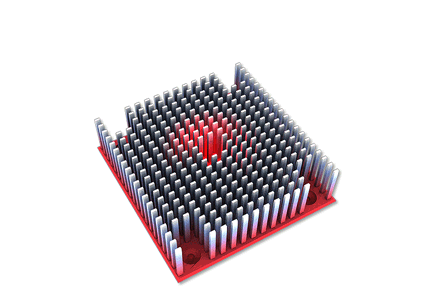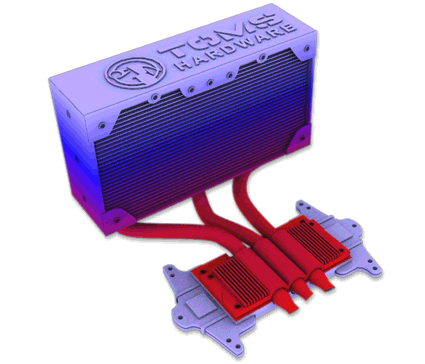Graphics Beginners' Guide, Part 1: Graphics Cards
Cooling Devices
Graphics cards can use the same power as that of a 150 Watt lamp. With so much power running through today's integrated circuits, the internal thermal resistance from the flow of electricity creates enormous amounts of heat. This heat can kill these devices if they are not properly cooled. Cooling ensures that it runs stably and smoothly. Without coolers and heatsinks, the graphics processor or the graphics memory could overheat and likely cause your computer to crash, lock up or permanently damage the device.
These cooling components can be passive-meaning they are built with thermo conductive materials and do their job statically and quietly - or they can be active - meaning noisy parts , like fans, are required.
Heatsinks
The term heatsink usually refers to a passive type of cooler. A heatsink lowers the temperature of whatever it is attached to by conducting heat and increasing the total surface area, which in turn boosts the devices' ability to dissipate heat. Heatsinks typically do this with fins and can usually be found on the graphics processor and the memory. Small heatsinks are also sometimes employed on other parts of the graphics card that get hot.
Heat Pipes
Especially passively cooled graphics cards rely on heat pipe cooling solutions. This Radeon X1600 card by Asus has two heat pipes that conduct heat to a large heat sink at the back of the card.
The larger the surface of a heat sink, the better heat dissipation can work (which is usually assisted by a fan). But sometimes it is impossible to deploy large-scale heat sinks onto the device that requires cooling due to space constraints. Some devices are so small that a bulky heatsink will not work properly as there is not much conductive material touching the electronic device. In such cases, a heat pipe helps to transfer heat from a hot spot to a more substantial heat sink. Typically, a highly heat conductive metal is being placed onto the graphics chip. The heat pipe is directly attached to this metal plate and transfers heat to a heat sink at the other end of the pipe, where it can be dissipated easily.
Get Tom's Hardware's best news and in-depth reviews, straight to your inbox.
George Grover at the Los Alamos National Laboratory developed a convection and evaporative cooling system. The development allows small devices to be attached to larger cooling elements in order to provide adequate cooling for ever shrinking components, such as graphics processing units (GPU) and central processing units (CPUs).
Many processor cooling devices with heat pipe elements are on the market, and we are thus seeing more graphics cooling solutions incorporating heat pipe technology.
Don Woligroski was a former senior hardware editor for Tom's Hardware. He has covered a wide range of PC hardware topics, including CPUs, GPUs, system building, and emerging technologies.

